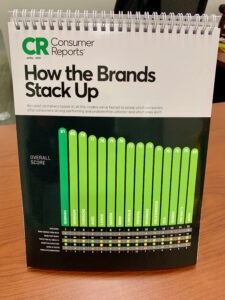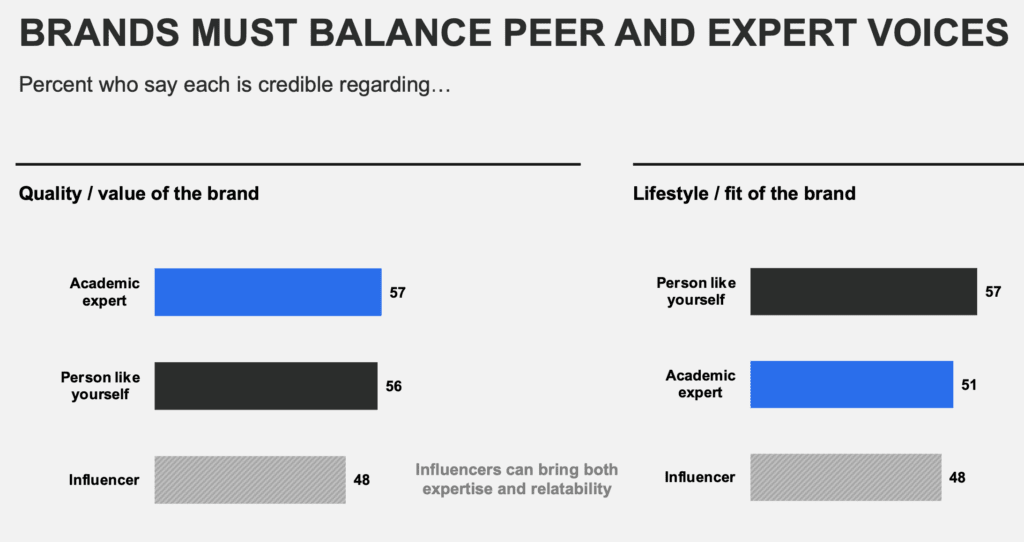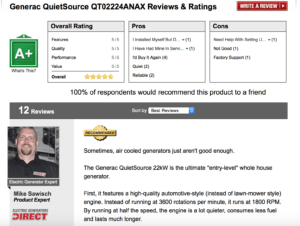
Content Marketing: Helping Buyers Comparison Shop to Build Relationships & Grow Sales

A marketer from AutoNation asked a question about whether a multibrand retailer should help buyers with comparison shopping.
“How can we create relevant content without upsetting our manufacturer relationships? For example, giving a comparison of two vehicles from different manufacturers?”
This question about comparison shopping ranks among the Top 100 Questions on content marketing.
You win by helping buyers comparison shop
Smart shoppers comparison shop.
On a carefully considered purchase, in the second step of the buyer’s journey, buyers actively evaluate buying options — including different makes of cars.
I strongly recommend that content marketers help customers with their comparison shopping. Including price comparisons.
Furnish objective third-party content such as reviews, ratings, rankings, and customer testimonials. All of this will help people comparison shop.
Why should marketers help buyers by becoming a comparison-shopping engine?
Because everything you do that helps buyers complete evaluations quicker reduces friction and advances buyers toward a purchase.
Buyers who get help with comparison shopping make decisions sooner rather than later. Because they save time on comparison shopping and price shopping, you gain revenue and customers faster.
For example, my local car dealer points to a third party, Consumer Reports, and its reviews of automobiles. Here’s what they display on the salesperson’s desk:

When I read reviews from third parties like Consumer Reports, I quickly figure out which vehicle will fit my needs better, so I buy sooner. And I’m more satisfied with my purchase later on.
That’s why as a buyer I feel better about car dealers who volunteer third-party content, compared with those who don’t.
Less friction for buyers during comparison shopping means more action: more deals get done.
That’s why you’ll want to bundle similar content together to get buyers to binge on content.
What do your happy customers tell other people?
Another way to help buyers narrow their options is to refer them to happy customers who already bought a car from you.
Help buyers hear first-hand from someone like themselves. Here’s why.
Edelman’s Trust Barometer research shows that a “person like yourself” holds high credibility, ranking slightly behind academic experts in credibility.

Content marketers, here’s how you can make the most out of your customers’ testimonials as content.
Real-life example: friends bought the same make and model of car we own, after enjoying a ride in our new car.
Of course, we were delighted to rant about our choice. We especially enjoy the 50 miles per gallon we get from our Toyota Prius.
Our friends even asked us for the name of the salesperson we worked with!
Are you putting customers or transactions first?
What’s the most important thing about helping buyers comparison shop? When you decide to help buyers speed their active evaluation, you build relationships, rather than just ring up transactions.
Your brand (and every brand) has this tough choice to make. Are you primarily about making transactions today or creating customer relationships for tomorrow?
The answer to that question will guide your brand’s willingness to help car buyers evaluate various brands.
I hope you put the long-term interests of your brand first by choosing to build relationships first. In the long run, you also win more transactions that way.
Be bold: help buyers comparison shop
Remember, the lack of easy comparisons sends buyers away. So it costs you sales.
Where can you find one of the biggest upsides in content marketing? Understand what buyers need in each step of the buyers’ journey — and provide the content they need at each step.
That’s what mapping your content to the buyers’ journey is all about.
In carefully considered consumer and business purchases, buyers first decide:
- Is there really a problem?
- Is it serious?
- And Finally, is it serious enough to change the status quo?
To maximize your opportunities, magnify the problem. Once you convince buyers to address a problem, they need to compare their options.
Then, help buyers comparison shop to advance them smoothly through step 2. As you educate buyers about how to compare, you gain the opportunity to maximize the differentiation among your offerings.
Provide easy comparison tables and charts to make these comparisons visual.
Is it easy to compare all your offerings?
Start by making it easy to compare all of your company’s offerings with each other.
If you sell 3 product lines that address a buyer’s problem, create a table to show how these 3 lines compare at a glance.
Make it easier for buyers to do their homework and they will purchase sooner.
Next, compare with competitors.
What could buyers buy from you or from competitors to address the problem? List their options and compare.
Marketers often resist naming competitors in the content on their websites.
But as you look through the eyes of buyers, you see that these competitors turn up on page one of Google search.
Chances are good that your buyers know your competitors already. That’s part of the customers’ experience.
By helping buyers comparison shop, you have much to gain and little to lose.

- Prices
- Buyers’ overall ratings
- A handy summary of pros and cons
- Recommendations
- Responses to buyers’ comments from a product expert.
Wow! That’s highly useful content for buyers.
It saves them time and hassle – and keeps them on one website. It helps them get the buying journey done faster.
What happens if you don’t enable buyers to compare competitive offerings?
Chances are, they’ll make those comparisons anyway by clicking away from your content. They’ll go back to Google or a competitor to continue their buying journey.
Most websites lack robust competitive comparisons. That’s a huge missed opportunity for content marketing — may be the biggest miss overall.
You know that buyers comparison shop for prices. In usability testing, Jakob Nielsen learned that buyers usually go to competitors’ websites when they don’t find an exact price or a sample price on your site. Why?
Because buyers are not asking, “What are all the things I can buy from Your Company?”
They’re asking, “What are all the different options I can buy from X, Y, and Z – even companies I never heard of before? How should I compare?”
Give your content a competitive check-up
- Do you mention competitors on your website by name?
- Do you mention specific products your competitors offer?
- Are you showing how your products compare with competitors’?
That’s what buyers really want.
If they don’t find what they need on your website, they go elsewhere. So you could lose up to half of your revenue opportunities.
Admittedly, sellers have long pretended there’s no competition, and no competitor worth mentioning. But with the Internet, social media, and content marketing, are there any buyers left who still believe that?
Be bold: Help buyers compare.
Clarify trade-offs for comparison shoppers. Spell out which product has:
- Higher quality vs. lower quality
- Many features vs. few features
- Simpler design vs. complex design
- Better service vs. little to no service
- Faster fulfillment vs. slower fulfillment
- Lower first cost vs. lower operating cost
- Higher price vs. lower price.
Any brand needs to excel in one or more areas in order to earn business.
Consider this: your products may look even better to buyers with a competitive comparison than without one.
- In which of these dimensions does your product excel?
- How clear are your competitive advantages in your content marketing?
- If you boldly offer a competitive comparison, will your differentiation become even clearer to buyers?
Great content helps buyers buy sooner
Put buyers a step ahead. Keep them advancing through your content by offering the help they need, when they need it.
A thorough competitive comparison could be one of the biggest upsides for your content marketing in the year ahead.
Contact Us




